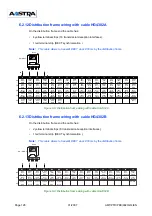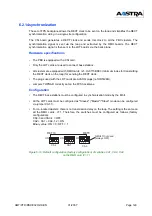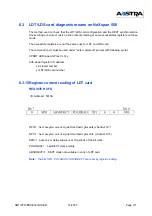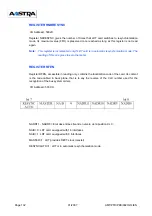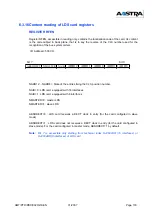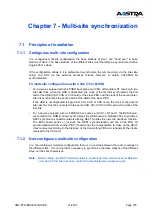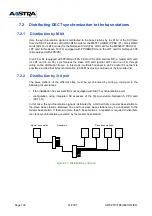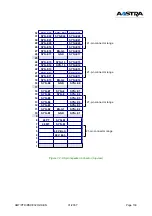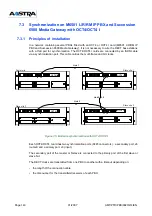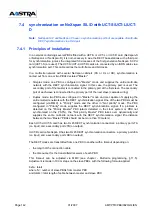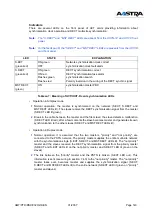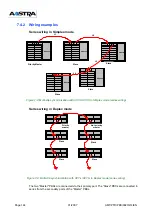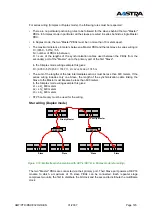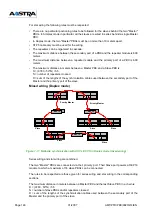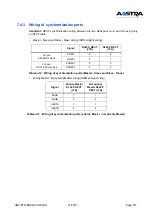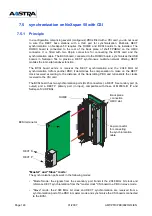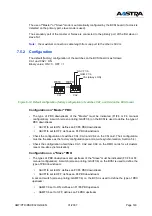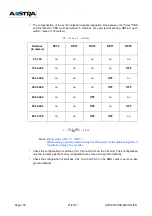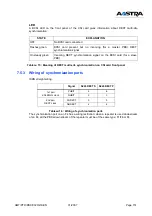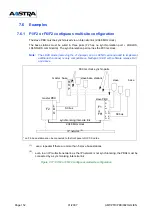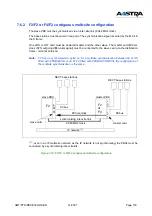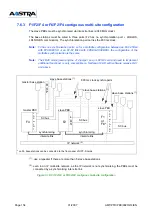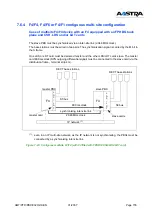
Page 142
01/2007
AMT/PTD/PBX/0020/2/4/EN
7.4
synchronization on NeXspan S/L/D with UCT-S/UCT-L/UCT-
D
Note:
NeXspan S12 and NeXspan C have no synchronisation port but are capable of multi-site
DECT synchronisation via a third pair.
7.4.1
Principles of installation
In a network containing several PBXs fitted with a UCT-S or UCT-L or UCT-D card (NeXspan-S
or NeXspan-L or NeXspan-D), it is not necessary to wire the DECT base stations with a third pair
for synchronization (unless the integrated S0 accesses of the first generation NeXspan S CPU
card (UCT1-S) are used). The UCT-S/UCT-L/UCT-D cards are connected by an ISDN cable via a
synchronization port. This cable carries the multi-frame and bit clocks.
In a multi-site network with several NeXspan cabinets (XS or XL or XD), synchronization is
carried out from one or two PBXs declared "Master".
•
Simplex mode: one PBX is configured in "Master" mode and supplies the entire multi-site
network with the DECT synchronization signal. In this case, the primary port is used. The
secondary port of the master is connected to the primary port of the first slave. The secondary
port of each slave is connected to the primary port of the next slave (cascade wiring).
•
Duplex mode: two PBXs are configured in "Master" mode and are capable of supplying the
entire multi-site network with the DECT synchronization signal. One of the two PBXs must be
configured (via MMC) in "Priority" mode and the other in "Not priority" mode. The PBX
configured in "Priority" mode supplies the DECT synchronization signal. If a problem is
detected on the "Priority Master" PBX (alarm detected in the clock system or PBX not
synchronized on the PSTN), the "Not priority Master" PBX takes over dynamically and
supplies the entire multi-site network with the DECT synchronization signal (the distance
between the two “Master” PBXs should not be more than 10 meters) .
Each UCT-L/UCT-S card has two RJ45 DECT synchronization connectors: a primary port J7A
(on input) and a secondary port J7B (on output).
IUCT-D card on NeXspan D has two RJ45 DECT synchronization connectors: a primary port J8A
(on input) and a secondary port J8B (on output).
The DECT clocks are transmitted from one PBX to another with a timeout depending on:
•
the length of the connection cable
•
the timeout set for the transmitters/receivers of each PBX.
This timeout can be adjusted via MMC (see chapter - Multi-site programming, § 11.5).
Adjustment is made in 100 m steps on the slave PBXs, with the following formula applied:
8xN + totalL
where N = number of slave PBXs from master PBX
and totalL = total length of cable between master and slave PBX
Summary of Contents for NeXspan C
Page 2: ...Page 2 01 2007 AMT PTD PBX 0020 2 4 EN...
Page 20: ...Page 20 01 2007 AMT PTD PBX 0020 2 4 EN...
Page 66: ...Page 66 01 2007 AMT PTD PBX 0020 2 4 EN...
Page 70: ...Page 70 01 2007 AMT PTD PBX 0020 2 4 EN Figure 4 2 Bottom view of the LD4 ST card...
Page 134: ...Page 134 01 2007 AMT PTD PBX 0020 2 4 EN...

